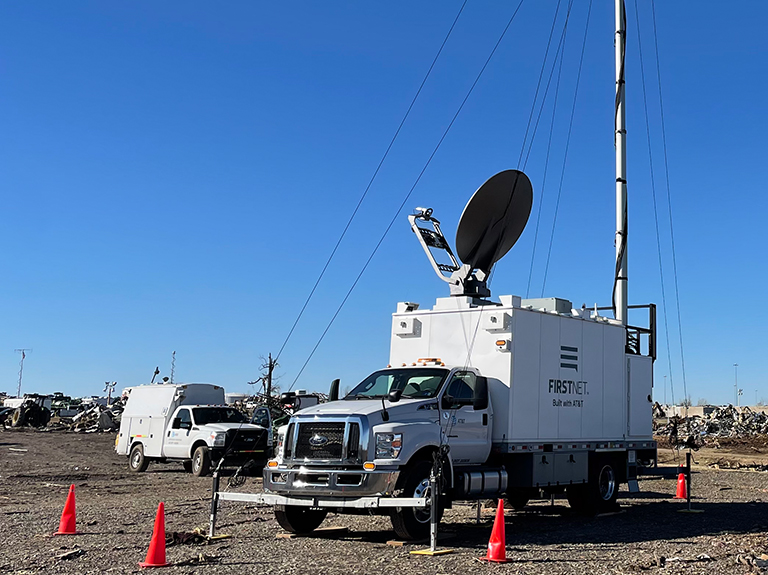The events of Sept. 11, 2001 changed the world as we knew it. Lives were lost, major economic and societal impacts struck the nation, and first responders’ inability to talk with one another in an emergency was exposed. This is what led to the creation of FirstNet – the only nationwide, high-speed broadband communications platform dedicated to and purpose-built for America’s first responders and the extended public safety community.
Once again, our country is experiencing a national crisis likely to change the way we operate. And while we don’t fully know how the COVID-19 pandemic will affect the future, we do know that with FirstNet, public safety can be confident in their critical communications capabilities as they effectively coordinate and respond today and for decades to come.
Just under three years ago on March 30, 2017, the federal government selected AT&T to enter into a public-private partnership to build and manage public safety’s network. We have a responsibility unlike any other wireless carrier during the coronavirus pandemic. And while no other major provider stepped forward to answer public safety’s call for the creation of their own wireless network, I am honored to have the privilege to serve this brave community that stands on the front lines, no matter the emergency.
One of AT&T’s core values is to Be There when people need us. And with FirstNet, that’s exactly what we do. Where public safety goes, we go. We’ve answered the call for tornadoes, hurricanes, wildfires, floods and other natural disasters. But with COVID-19, it is like experiencing a perpetual emergency in every community across the country. Public safety’s network is being tested in a completely new way, and it’s hitting the mark.
FirstNet Isn’t Just a Rate Plan
Using all AT&T LTE spectrum bands, FirstNet already covers more than 99% of the U.S. population today. This gives first responders always-on, 24-hours a day priority and preemption across voice and data. Subscribers don’t have to manually turn it on - it’s ready for any situation at any time without a second thought. And to help ensure first responders have as much coverage and capacity as possible, as well as a dedicated lane of connectivity whenever they need it, we’ve deployed Band 14 spectrum in areas across the country where public safety told us they need it most. This VIP communications lane, coupled with always-ready access means FirstNet subscribers are protected against commercial traffic congestion. That’s unique in the industry and something public safety won’t get anywhere but on the FirstNet network – after all, it’s much more than just a rate plan.
So, as major cities like New York, Chicago, Dallas and L.A. stand up quarantine zones or testing centers in arenas and other venues, FirstNet is there, keeping responders connected. For medical facilities and agencies in rural and tribal communities – like the Miccosukee Tribe in the Florida Everglades – FirstNet is there, keeping responders connected. And when public safety needs to quickly enhance their network with additional capacity due to increased foot traffic, FirstNet is there. Here are just a few examples:
- In northern California, a medical center contacted FirstNet for device and network support. We quickly deployed a FirstNet COW (Cell on Wheels) to provide additional capacity and keep emergency personnel connected. Plus, we’ve sent FirstNet Ready™ devices to support critical care physicians and ER nurses, as well as remote workers and noncritical staff.
- In the Northeast, one of the hardest hit areas of the country, we’ve deployed a FirstNet portable cell site and other devices to support a drive-through testing facility. The public safety and emergency management teams were concerned about maintaining reliable communications when thousands of citizens arrive for testing. But with FirstNet, medical professionals and first responders can interoperate across federal, state and local agencies, and are not competing with consumer smartphones and tablets for bandwidth in the drive-through.
- In Texas, public safety requested FirstNet network support for a quarantine center at a military base. While there was quality coverage outside of the quarantine center, within the quarantine zone service was minimal. The FirstNet team at AT&T quickly deployed a new in-building emergency solution to support dozens of first responders.
It's amazing to see and hear about the selfless sacrifices made every day by these public servants – the first responders, medical professionals and more who tirelessly serve our communities. I’m humbled by the role our company plays in serving these heroes and I plan to share many more stories of the women and men supporting the incredible work of medical professionals and first responders at quarantine sites, trauma centers and other areas throughout this great country.
As public safety’s communications network partner, we’re helping deliver on the vision of Congress and the first responder community. With dedicated, advanced services built to mission-critical standards interoperating across agencies and jurisdictions, custom apps and devices built for law enforcement, fire and EMS, it’s clear FirstNet stands above best-effort commercial offerings. And more than 11,000 public safety agencies and organizations – accounting for over 1.2 million connections – would agree.
So, as the nation continues to combat the spread of coronavirus, rest assured, FirstNet was built for this situation. It’s exactly what public safety designed it for.


